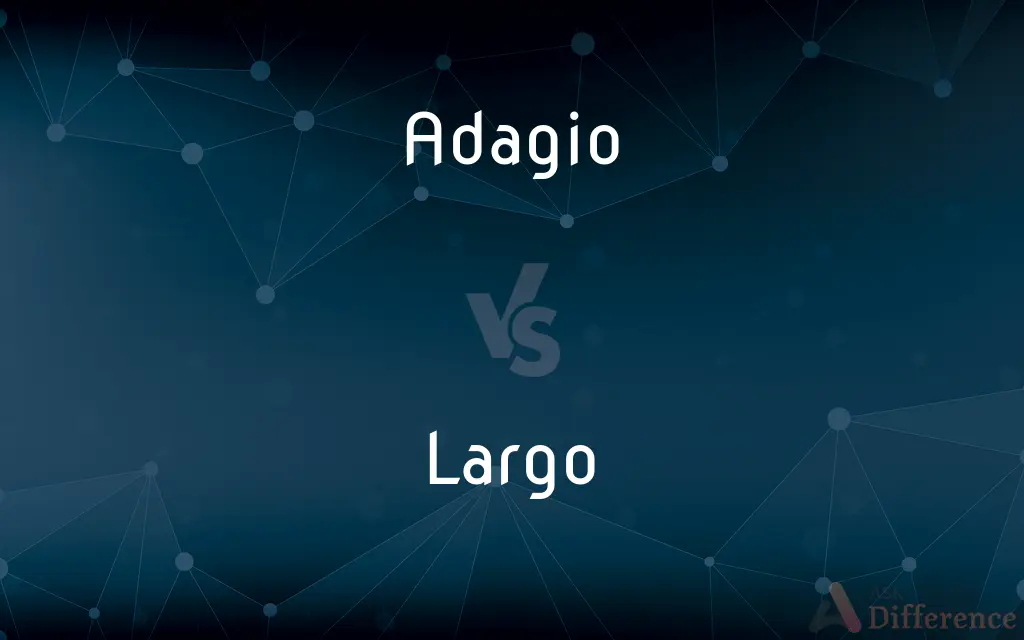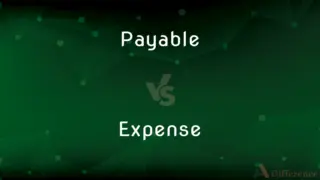Adagio vs. Largo — What's the Difference?
By Fiza Rafique & Urooj Arif — Updated on March 26, 2024
Adagio and Largo are both musical terms that indicate a slow tempo, but adagio is slightly faster than largo, which represents one of the slowest tempos in music.

Difference Between Adagio and Largo
Table of Contents
ADVERTISEMENT
Key Differences
Adagio signifies a tempo that is slow and stately, allowing for expressive and leisurely music performance. On the other hand, largo denotes a very slow and broad tempo, often conveying a grand, expansive, or solemn mood.
In terms of metronome markings, adagio typically falls between 66 and 76 beats per minute (BPM), suggesting a pace that, while leisurely, maintains a certain flow. Largo, however, ranges around 40 to 60 BPM, creating a more pronounced sense of spaciousness and breadth in the music.
Composers use adagio to express a wide range of emotions, often leaning towards the introspective and contemplative, without losing momentum. Largo, by contrast, is used to evoke a profound depth of feeling, emphasizing majesty or solemnity that requires a more deliberate pace.
While both terms are used to instruct performers on the tempo of a piece, the choice between adagio and largo can significantly affect the emotional and atmospheric impact of the music, reflecting the composer's intent and the piece's overall character.
Comparison Chart
Tempo
Slow and stately (66-76 BPM)
Very slow and broad (40-60 BPM)
ADVERTISEMENT
Emotional Tone
Expressive, introspective, contemplative
Grand, majestic, solemn
Pace
Leisurely but with a certain flow
Pronounced spaciousness and breadth
Use in Music
Conveys a range of emotions
Evokes depth of feeling, majesty, solemnity
Metronome Marks
Typically 66-76 beats per minute
Around 40-60 beats per minute
Compare with Definitions
Adagio
A tempo marking indicating a slow and stately pace.
The adagio movement in Beethoven's Symphony No. 9 allows for expressive interpretation.
Largo
Used to create a sense of grandeur or profound solemnity.
The largo passage underscored the music's majestic quality.
Adagio
Often used to highlight the emotional depth of a piece.
The adagio section gave the soloist a chance to showcase expressive dynamics.
Largo
Indicates a very slow tempo, often the slowest in classical music compositions.
The largo opening of Dvorak's New World Symphony sets a solemn tone.
Adagio
Implies a tempo that is leisurely yet flowing.
The quartet played the adagio with a beautifully controlled pace.
Largo
Reflects a deliberate spaciousness in the music.
Handel's Largo from Xerxes is renowned for its expansive melody.
Adagio
Can be both a tempo marking and a description of a piece's character.
The adagio from Mozart's Clarinet Concerto is among the most beloved in classical music.
Largo
Emphasizes the depth of emotion through a broad, slow pace.
The largo movement provided a deep, reflective moment in the concert.
Adagio
In a slow tempo, usually considered to be slower than andante but faster than larghetto. Used chiefly as a direction.
Largo
In a very slow tempo, usually considered to be slower than adagio, and with great dignity. Used chiefly as a direction.
Adagio
(Music) A slow passage, movement, or work, especially one using adagio as the direction.
Largo
A largo passage or movement.
Adagio
A section of a pas de deux in which the ballerina and her partner perform steps requiring lyricism and great skill in lifting, balancing, and turning.
Largo
(music) a very slow tempo
Adagio
A succession of slow, fluid movements performed as an exercise in ballet.
Largo
(music) a musical piece or movement in such a tempo
Adagio
(music) A tempo mark directing that a passage is to be played rather slowly, leisurely and gracefully.
Largo
(music) strong and stately
Adagio
(music) A passage having this mark.
Largo
Slow or slowly; - more so than adagio; next in slowness to grave, which is also weighty and solemn.
Adagio
(dance) A male-female duet or mixed trio ballet displaying demanding balance, spins and/or lifts.
Largo
(music) a composition or passage that is to be performed in a slow and dignified manner
Adagio
(music) Played rather slowly.
Largo
Very slow in tempo and broad in manner
Adagio
(music) Describing a passage having this mark.
Largo
Slowly and broadly
Adagio
Slow; slowly, leisurely, and gracefully. When repeated, adagio, adagio, it directs the movement to be very slow.
Adagio
A piece of music in adagio time; a slow movement; as, an adagio of Haydn.
Adagio
(music) a composition played in adagio tempo (slowly and gracefully);
They played the adagio too quickly
Adagio
A slow section of a pas de deux requiring great skill and strength by the dancers
Adagio
(of tempo) leisurely
Adagio
Slowly;
Here you must play adagio
Common Curiosities
How do musicians interpret adagio and largo in performance?
Musicians interpret these tempos by adjusting their playing to match the pace and emotional tone suggested by the music, often focusing on expressive qualities for adagio and a more expansive, profound expression for largo.
Can both adagio and largo convey deep emotions?
Yes, both can convey deep emotions, but largo tends to emphasize grandeur or solemnity due to its slower pace.
Does the choice between adagio and largo affect the overall character of a piece?
Yes, the choice significantly affects the piece's character, with adagio allowing for expressive but flowing music, and largo creating a deeper, more solemn atmosphere.
Is adagio or largo used more frequently in music?
Both are commonly used, depending on the composer's intent and the emotional tone they wish to convey.
How do composers decide whether to use adagio or largo?
Composers decide based on the emotional and atmospheric effect they wish to achieve in their music, considering the tempo's impact on the piece's expression and mood.
Can adagio and largo sections be found within the same piece?
Yes, a single piece can contain both adagio and largo sections, showcasing a range of tempos and emotions.
What is the main difference between adagio and largo?
The main difference lies in their tempo; adagio is slow and stately, while largo is very slow and broad, making it one of the slowest tempos in music.
Can the terms adagio and largo be used interchangeably?
While both indicate slow tempos, they cannot be used interchangeably due to the distinct degrees of slowness and emotional atmospheres they represent.
Are there specific instruments or ensembles that prefer adagio or largo?
The choice between adagio and largo is not instrument-specific but depends on the musical composition's overall mood and character.
How should new musicians approach learning pieces marked adagio or largo?
New musicians should focus on controlling their pace, emphasizing expressive qualities for adagio and a sense of grandeur or depth for largo, paying close attention to the desired emotional tone.
Share Your Discovery

Previous Comparison
Pertain vs. Pertinent
Next Comparison
Payable vs. ExpenseAuthor Spotlight
Written by
Fiza RafiqueFiza Rafique is a skilled content writer at AskDifference.com, where she meticulously refines and enhances written pieces. Drawing from her vast editorial expertise, Fiza ensures clarity, accuracy, and precision in every article. Passionate about language, she continually seeks to elevate the quality of content for readers worldwide.
Co-written by
Urooj ArifUrooj is a skilled content writer at Ask Difference, known for her exceptional ability to simplify complex topics into engaging and informative content. With a passion for research and a flair for clear, concise writing, she consistently delivers articles that resonate with our diverse audience.














































